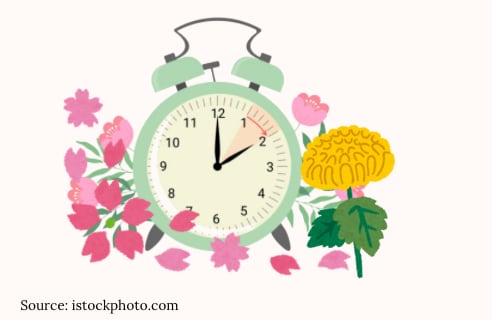It’s that time of year again! Twice a year, millions of people adjust their clocks forward and backward for Daylight Saving Time. This year, it falls on March 9th, where all of our clocks will be moving one hour ahead. As we approach Daylight Saving Time, it is important to understand its origins and why we have it, and even more significant, the effects it can have on our health.
What is Daylight Saving Time?
Daylight Saving Time is when clocks jump one hour forward in March, and then one hour back in November. The purpose of Daylight Saving Time is to conserve energy by making the most out of human activity during the daylight hours. Most countries in the Northern Hemisphere observe Daylight Saving Time including many in Europe, as well as most of North America.
The Origins of Daylight Saving Time
Daylight Saving Time first emerged in 1784 when Benjamin Franklin came up with the idea that waking up earlier would allow people to save more money and make candle usage less expensive. It was not until March 19th, 1918, when The Standard Time Act was passed. This established Daylight Saving Time which would help to conserve energy and save energy costs during the midst of World War I. However, this was a very controversial idea, and the law was revoked in 1919 as a result of the war ending.
Then, during World War II, the concept was revived and starting in February of 1942, it became observed nationally to conserve fuel and “promote national security and defense,” until September 30, 1945. This contributed to Daylight Saving Time earning the nickname, “war time.” Once again, however, after the end of World War II, the law was repealed to allow states to create their own standard time. After several years of confusion regarding daylight saving time, Congress finally passed the Uniform Time Act in 1966 which provided a permanent national standard time to be used nationwide, although states could opt out of it. We currently observe the policy established by President George W. Bush in 2005, who changed Daylight Saving Time to be a few weeks longer.
Impacts on Peoples’ Health
Every year during Daylight Saving Time, many people remain unaware of the unfortunate health consequences that can occur in our bodies, especially regarding sleep. First, it is important to understand the two processes that allow us to sleep: sleep homeostasis and circadian rhythm. Sleep homeostasis is having the urge to sleep that begins from when you wake up to when you go back to sleep. Circadian rhythm is the 24-hour biological cycle or clock of the body that regulates sleeping and waking up in response to the changes in the environment. This depends on the light exposure that a person experiences and since your body is exposed to more evening light and less morning light during Daylight Saving Time, your circadian rhythm can be affected. This will lead to your sleep patterns being thrown off, which can negatively impact your sleep health. The time changes can also cause people to experience similar symptoms that would normally happen from travelling to a different time zone, eventually resulting in short-term health problems like sleep deprivation, changes in blood pressure, and fatigue. More serious long-term effects are also prone to occur including depression, slowed metabolism, weight gain, and cluster headaches. Additionally, research has proved that during the week after the time change, there are increases in cardiovascular disease, injuries, stroke rate, mental health, and digestive and immune-related diseases.
How to Preserve a Healthy Sleep Schedule
Now that you know the health effects of Daylight Saving Time, you might be wondering – How can I keep my body healthy during this change? There are several different measures you can take in order to save sleep during this time – one of the most important being maintaining a consistent sleep routine by ensuring that you get seven to nine hours of sleep every night. A lot of students, especially those at Staten Island Tech, tend to not sleep as much as they should because of several factors like homework, studying, jobs, and family responsibilities. While it might be difficult to get the appropriate amount of sleep every night, it is crucial that you do your best to sleep at a reasonable time depending on when you wake up, which can be done by practicing time management and scheduling. You should also maintain your circadian rhythm as best as you can so it is not altered too much. This can be done by going to sleep an hour before you normally would, and by enjoying natural light in the morning.
Conclusion
Daylight Saving Time may be a heavily debated topic, but it is highly important to take into consideration the effects that it could have on our health, and what we can do to remain less affected by the time change. Although the future for Daylight Saving Time remains uncertain, for now, don't forget to spring your clocks forward, and enjoy the extra daylight!
Works Cited
Astronomical Applications Department. “Daylight Saving Time.” U.S. Navy. https://aa.usno.navy.mil/faq/daylight_time.
C. Zee. Phyllis. “Daylight Saving Time and Your Health.” Northwestern Medicine. December 2024. https://www.nm.org/healthbeat/healthy-tips/daylight-savings-time-your-health#:~:text=During%20the%20week%20after%20the,Stroke%20rate.
Coulson, Morgan. “7 Things to Know About Daylight Saving Time.” Johns Hopkins Bloomberg School of Public Health. March 9, 2023. https://publichealth.jhu.edu/2023/7-things-to-know-about-daylight-saving-time#:~:text=Benjamin%20 Franklin%20invented%20the%20 concept,global%20attempt%20to%20conserve%20energy..
Lange, Katie. “Daylight Saving Time Once Known As ‘War Time.’” U.S. Department of Defence. March 8, 2019. https://www.defense.gov/News/Feature-Stories/story/Article/1779177/daylight-saving-time-once-known-as-war-time/















